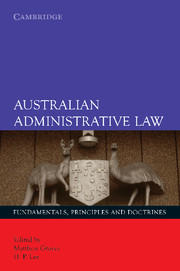Book contents
- Frontmatter
- Contents
- Foreword
- Preface
- About the contributors
- Table of cases
- Table of statutes
- 1 Australian administrative law: The constitutional and legal matrix
- 2 Administrative law in Australia: Themes and values
- 3 The public/private distinction in Australian administrative law
- 4 Australian administrative law: The human rights dimension
- 5 Administrative tribunals
- 6 Australian Ombudsman: A continual work in progress
- 7 Freedom of information
- 8 Delegated legislation
- 9 The concept of ‘justiciability’ in administrative law
- 10 Standing
- 11 Reasons for administrative decisions: Legal framework and reform
- 12 Relevant and irrelevant considerations
- 13 Improper purpose
- 14 Reasonableness, rationality and proportionality
- 15 The ‘no evidence’ rule
- 16 Failure to exercise discretion or perform duties
- 17 Procedural fairness: The hearing rule
- 18 The doctrine of substantive unfairness and the review of substantive legitimate expectations
- 19 The impact and significance of Teoh and Lam
- 20 The rule against bias
- 21 Jurisdictional error without the tears
- 22 Privative clauses and the limits of the law
- 23 Administrative law judicial remedies
- Endnotes
- Index
1 - Australian administrative law: The constitutional and legal matrix
Published online by Cambridge University Press: 05 June 2012
- Frontmatter
- Contents
- Foreword
- Preface
- About the contributors
- Table of cases
- Table of statutes
- 1 Australian administrative law: The constitutional and legal matrix
- 2 Administrative law in Australia: Themes and values
- 3 The public/private distinction in Australian administrative law
- 4 Australian administrative law: The human rights dimension
- 5 Administrative tribunals
- 6 Australian Ombudsman: A continual work in progress
- 7 Freedom of information
- 8 Delegated legislation
- 9 The concept of ‘justiciability’ in administrative law
- 10 Standing
- 11 Reasons for administrative decisions: Legal framework and reform
- 12 Relevant and irrelevant considerations
- 13 Improper purpose
- 14 Reasonableness, rationality and proportionality
- 15 The ‘no evidence’ rule
- 16 Failure to exercise discretion or perform duties
- 17 Procedural fairness: The hearing rule
- 18 The doctrine of substantive unfairness and the review of substantive legitimate expectations
- 19 The impact and significance of Teoh and Lam
- 20 The rule against bias
- 21 Jurisdictional error without the tears
- 22 Privative clauses and the limits of the law
- 23 Administrative law judicial remedies
- Endnotes
- Index
Summary
Administrative law is difficult to define, and we will not attempt to do so in an exact way. For most Australian scholars, administrative law might simply mean the parts of public law that do not include constitutional law – but many chapters of this book demonstrate that constitutional law and its consequences can never be entirely separated from administrative law. That said, administrative law can still be defined in part by reference to constitutional law. Constitutional law is largely concerned with the nature and scope of the powers held by each arm of government within the Constitution. Administrative law is all about what the agencies of the executive government (ministers, departments, agencies and the individual officials who work within these bodies) can and cannot do. More particularly, administrative law encompasses the different mechanisms and principles that enable people to question or challenge the decisions of these agencies of government.
While the courts play a significant role in these processes (principally through the exercise of their judicial review jurisdiction and, to a lesser extent, through their appellate jurisdiction over many other administrative decisions), they form only one part of the picture. A defining feature of administrative law is the important role played by non-judicial bodies, such as tribunals and Ombudsmen, who receive many more complaints than the courts. Another defining feature of administrative law is the different remedies offered by its different institutions.
- Type
- Chapter
- Information
- Australian Administrative LawFundamentals, Principles and Doctrines, pp. 1 - 14Publisher: Cambridge University PressPrint publication year: 2007
- 2
- Cited by

